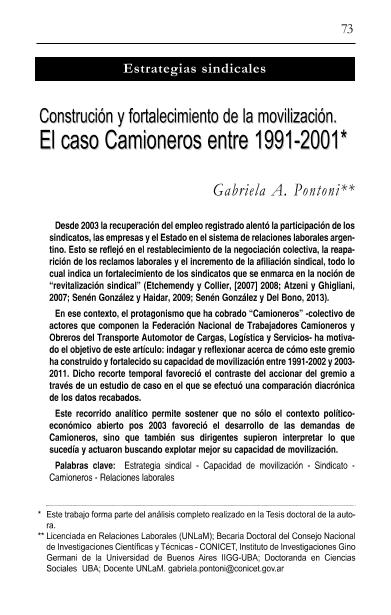Artículo
Desde 2003 la recuperación del empleo registrado alentó la participación de los sindicatos, las empresas y el Estado en el sistema de relaciones laborales argentino. Esto se reflejó en el restablecimiento de la negociación colectiva, la reaparición de los reclamos laborales y el incremento de la afiliación sindical, todo lo cual indica un fortalecimiento de los sindicatos que se enmarca en la noción de revitalización sindical(Etchemendy y Collier, [2007] 2008; Atzeni y Ghigliani, 2007; Senén González y Haidar, 2009; Senén González y Del Bono, 2013). En ese contexto, el protagonismo que ha cobrado Camioneros-colectivo de actores que componen la Federación Nacional de Trabajadores Camioneros y Obreros del Transporte Automotor de Cargas, Logística y Servicios- ha motivado el objetivo de este trabajo: indagar y reflexionar acerca de cómo este gremio ha construido y fortalecido su capacidad de movilización entre 1991-2002 y 2003-2011. Dicho recorte temporal favoreció el contraste del accionar del gremio a través de un estudio de caso en el que se efectuó una comparación diacrónica de los datos recabados. Este recorrido analítico permite sostener que no sólo el contexto político-económico abierto post 2003 favoreció el desarrollo de las demandas de aquel gremio, sino que también sus dirigentes supieron interpretar lo que sucedía y actuaron buscando explotar mejor su capacidad de movilización. Since 2003, the recovery of the registered employment rate in Argentina has encouraged the participation of trade unions, companies and of the state in the industrial relations system. This is reflected in the reestablishment of collective bargaining, in the reappearance of demands connected with labour issues and in the increasing union membership, all of which indicates a process of strengthening of trade unions that has been conceptualized under the notion of “union revitalization” (Etchemendy & Collier, [2007] 2008; Atzeni & Ghigliani, 2007; Senén González & Haidar, 2009; Senén González & Del Bono, 2013). In this context, the leading role that Truckers’ union have acquired –a group of social actors grouped in the National Federation of Truck Drivers and Workers of Motor Transport of Freights, Logistics and Services- has motivated the aim of this study: it is investigate and reflect on how this trade union has built and strengthened its capacity of mobilization between 1991-2002 and between 2003-2011. These periods of time have been chosen because they allow contrasting the actions of the trade union –taken as a case studythrough a diachronic comparison of the collected data. Our analysis show that not only the political-economic context initiated in 2003 favored the development of Truckers’ demands, but also was important the fact that their leaders knew how to interpret what was happening and they acted accordingly, trying to better exploit their capacity of mobilization.
Construcción y fortalecimiento de la movilización: El caso Camioneros entre 1991-2011
Título:
Building and strengthening of mobilization: The truckers case between 1991 and 2001
Fecha de publicación:
12/2013
Editorial:
Instituto Argentino para el Desarrollo Económico
Revista:
Realidad Económica
ISSN:
0325-1926
Idioma:
Español
Tipo de recurso:
Artículo publicado
Clasificación temática:
Resumen
Palabras clave:
Estrategia Sindical
,
Capacidad de Movilización
,
Camioneros
,
Argentina
Archivos asociados
Licencia
Identificadores
Colecciones
Articulos(SEDE CENTRAL)
Articulos de SEDE CENTRAL
Articulos de SEDE CENTRAL
Citación
Pontoni, Gabriela Alejandra; Construcción y fortalecimiento de la movilización: El caso Camioneros entre 1991-2011; Instituto Argentino para el Desarrollo Económico; Realidad Económica; 280; 12-2013; 73-103
Compartir




